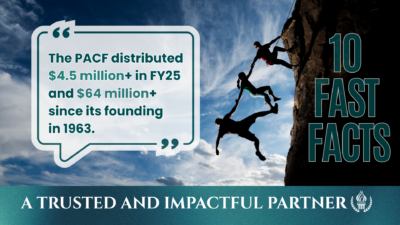
A Smart Way to Stay Focused on What Matters Most
With the holiday season just around the corner, now is a great time to start planning your 2026 charitable giving. While financial conditions may shift, one thing remains steady—our community’s ongoing needs.
By creating a charitable giving budget, you can continue to support the causes you care about most while maintaining financial balance. It’s a thoughtful way to ensure your giving stays aligned with both your values and your resources.
This is also an opportune time to involve your family in the planning process. You may consider having a conversation with your loved ones to learn more about their passions and priorities in the community!
How to Build a Giving Plan That Works for You
Here are a few practical steps to help you map out your charitable giving for the year ahead:
1. Look Back Before You Look Ahead
Review your donations from the past two to three years. Which organizations did you support? How much did you give? If you have an established fund with the PACF, you can log into your donor portal to review all gifts by date or review quarterly statements you received throughout the last year. Compile all gifts to charities, crowdfunding campaigns and churches to give yourself a composite picture of your charitable giving.
2. Focus on What Matters Most
Identify the nonprofits that align most closely with your values. These might be organizations where you volunteer, serve on a board, or have a personal connection. Consider the top 3 areas you are interested in.
The PACF categorizes needs by education, animal welfare, human needs, community development and public safety, arts and culture, and unrestricted/ greatest needs.
3. Pause One-Time Commitments
Consider whether some past donations were tied to temporary needs—like emergency appeals or fundraising events. You may consider breaking your giving into three categories;
- Continued Support
- New Priorities
- Emergency / Discretionary Giving
If your budget is tighter this year, it’s okay to put new priorities and discretionary giving on pause and concentrate on core giving priorities.
4. Choose a Giving Amount That Feels Right
Add up your average giving from recent years and adjust based on your current financial outlook. Whether you’re able to give more, less, or the same, planning ahead helps you make intentional choices—and it may open up tax-smart giving options, like donating appreciated stock or using a donor-advised fund.
5. Allocate by Priority
Decide how you want to divide your giving across organizations. You might continue supporting some at previous levels, reduce giving to others, or supplement smaller gifts with volunteer service or other forms of engagement.
6. Explore New Opportunities
Interested in addressing new or urgent needs? The PACF is here to help. We can connect you with trusted, impactful nonprofits doing meaningful work in the MOV. The PACF has supported over 600 nonprofits in the 11 counties it serves through thoughtful grantmaking and fund management. You can learn more about our most flexible funds by visiting our Search All Funds Page and reading more about the 6 featured grantmaking and support funds on the first page.
7. Set a Timeline for Giving
Consider spreading your gifts throughout the year—monthly, quarterly, or seasonally—whatever works best for your financial planning. Scheduled giving also helps nonprofits manage their budgets and plan ahead.
Intentional Giving Builds a Stronger Community
Being proactive about your giving allows you to stay connected to the causes that matter most—while also helping local nonprofits thrive in a changing environment. At the PACF, we’re thankful to partner with generous neighbors like you to make a lasting difference across our region.
Need a sounding board or want to talk through your giving plan? Our team is here to help. Contact Julie Posey to explore how you can make the most of your charitable impact in 2026.




